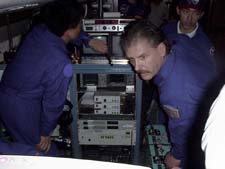|
Leonid MAC |
| home |
| View the shower |
| Mission Brief |
| Science Update |
| Media Brief |
| links |
 Thomas H. Hudson,
Thomas H. Hudson, Stewart Radiance Lab. 
Last updated: October 2001
Brief Biographical Information: Mr Hudson joined Stewart Radiance Laboratory in 1978 and has flown on the FISTA aircraft since that time. He has built and operated many sensors on the FISTA aircraft over the years, and has participated in many field campaigns with the aircraft. When not involved with FISTA field campaigns, he assists in ground field collections, tests and upgrades infrared instrumentation, and recently has designed and built the electronics for an airborne infrared calibration pod. Research: The FISTA group in the Space Dynamics Laboratory (SDL) is located in the Stewart Radiance Laboratory (SRL) facility in Bedford, MA. Numerous infrared and visible calibrated sensors have been developed there for the FISTA aircraft and other aircraft platforms. The primary business of the FISTA program is the conduct of airborne measurements of targets and backgrounds of interest to the US DoD. SDL has a contract with the Air Force Research Laboratory, Backgrounds Characterization Branch (AFRL/VSBC) to develop, operate, and fly sensors in the FISTA program. SRL has built Michelson interferometers suitable for an aircraft platform, as well as high speed radiometers and calibrated infrared imaging systems. It is currently developing advanced sensors such as imaging infrared interferometers and high speed radiometric systems. The parent organization, Space Dynamics Laboratory, has built and flown many sensors for rocket and satellite platforms, including the Space Shuttle and other long-term orbiting systems. Research on Leonid MAC: near-IR (1.0-3.1 micron) spectroscopy of meteors and trains.The AFRL/SRL team is also assisting many of the other FISTA aircraft users in the interface and installation of their equipment on the aircraft. During the 1999 Leonid multi-aircraft campaign, Mr Hudson worked with the AFRL and SRL research teams to operate three instruments: 2 Michelson interferometers and one infrared imager. The two interferometers cover the 1 to 3 micrometer band of the spectrum. These instruments will be tracked onto the persistent meteor trains to try and spectrally measure the emission in this band, which should help identify the radiating species and give insight into exactly what is happening in a persistent train. Each interferometer has a co-aligned low light level sensor so that the small field of view of the interferometer can be directed onto the persistent train. Results included the detection of an increase of OH emission at the peak of the meteor storm (more info here), and the first detection of meteors in the near-IR (unpublished data). During the 2001 Leonid MAC mission, a Bomem spectrograph will be deployed in an effort to confirm the increase of OH coincident with the meteor storm. In addition, three mid-IR imagers will be deployed from FISTA with bandpass filters chosen to pick up the 3.4 um band, in tsearch for organic matter release. Our equipment continues to improve (our continuous digital recording software is much better than during Leonid 99). One innovation we have been developing (for reasons utterly unrelated to meteors) is the capability to record our IR imagery at extremely high data rates, providing potentially a VERY detailed time history of its spatial structure if a bright enough meteor passes its field of view. |

